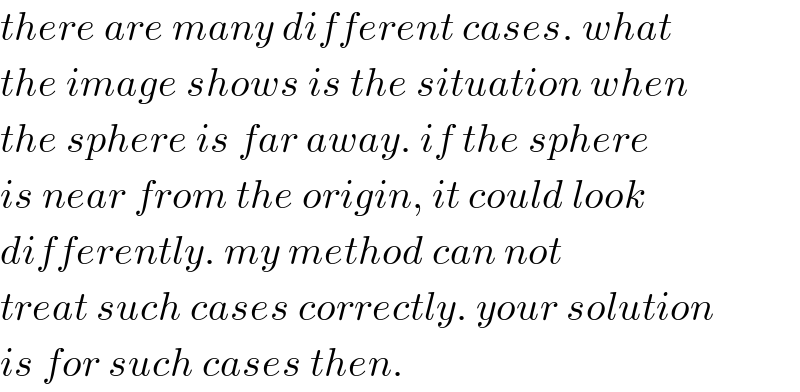
Question and Answers Forum
Question Number 72672 by mr W last updated on 31/Oct/19

Commented by mr W last updated on 31/Oct/19

Commented by malwaan last updated on 31/Oct/19

Answered by ajfour last updated on 31/Oct/19

Answered by mr W last updated on 31/Oct/19

Commented by mr W last updated on 31/Oct/19

Commented by mr W last updated on 31/Oct/19
![x=u cos θ t y=u sin θ t−((gt^2 )/2) y=x tan θ−(g/(2u^2 ))(1+tan^2 θ)x^2 let t=tan θ y=tx−(g/(2u^2 ))(1+t^2 )x^2 y′=t−((g(1+t^2 )x)/u^2 ) B(d+R sin ϕ, R(1+cos ϕ)) −tan ϕ=t−((g(1+t^2 )(d+R sin ϕ))/u^2 ) ⇒((g(1+t^2 )(d+R sin ϕ))/u^2 )=t+tan ϕ R(1+cos ϕ)=t(d+R sin ϕ)−(g/(2u^2 ))(1+t^2 )(d+R sin ϕ)^2 R(1+cos ϕ)=t(d+R sin ϕ)−(((d+R sin ϕ)(t+tan ϕ))/2) ⇒t=tan ϕ+((2(1+cos ϕ))/(δ+sin ϕ)) with δ=(d/R) ⇒((gR(1+t^2 )(δ+sin ϕ))/u^2 )=t+tan ϕ ⇒((gR)/u^2 )=((t+tan ϕ)/((δ+sin ϕ)(1+t^2 ))) ⇒((gR)/(2u^2 ))=U=((1+cos ϕ+(δ+sin ϕ)tan ϕ)/((δ+sin ϕ)^2 +[(δ+sin ϕ)tan ϕ+2(1+cos ϕ)]^2 )) (dU/dϕ)=0 .....](Q72701.png)
Commented by mr W last updated on 31/Oct/19

Commented by ajfour last updated on 31/Oct/19

Commented by mr W last updated on 31/Oct/19

